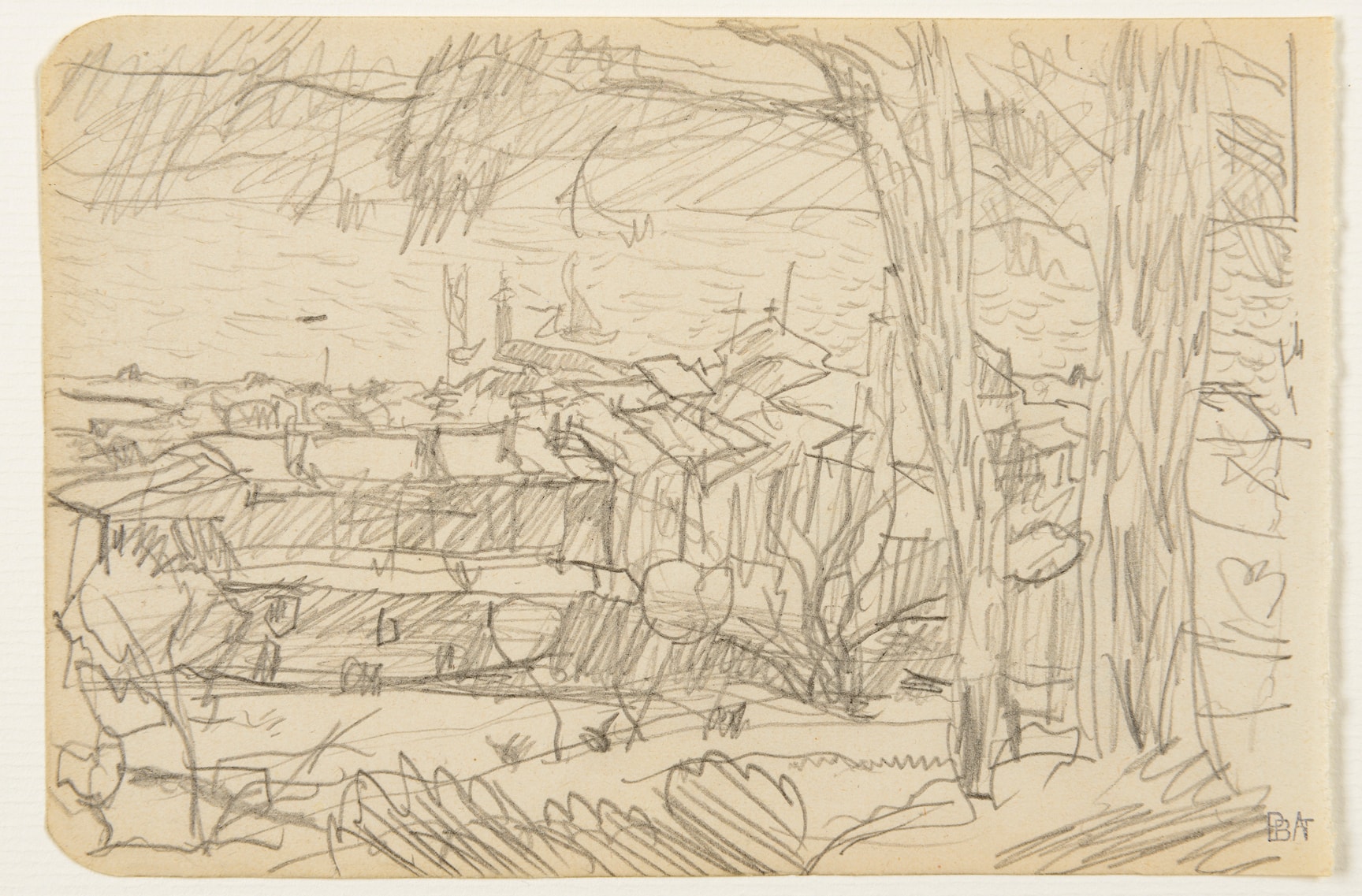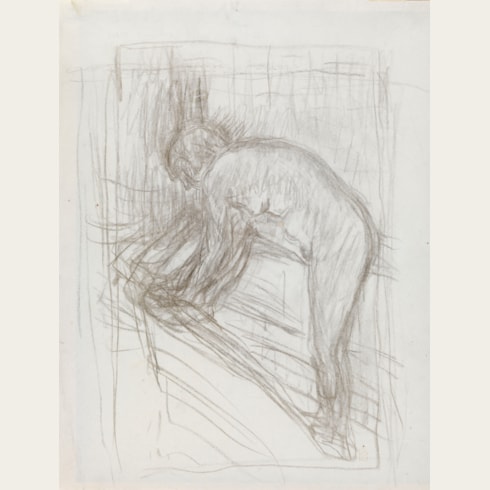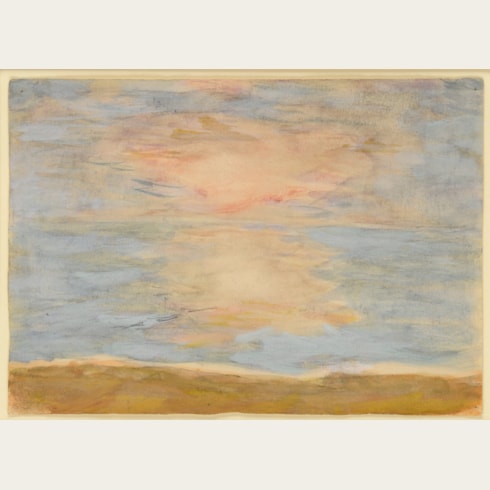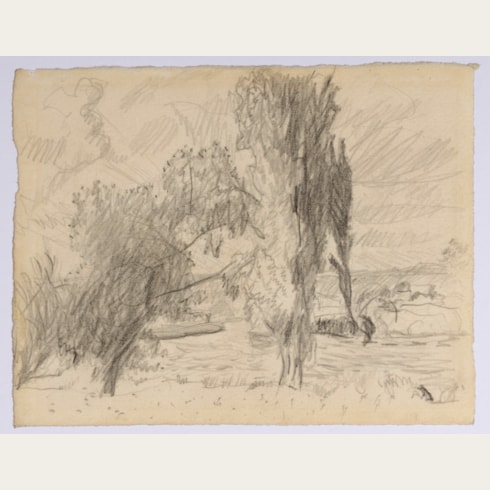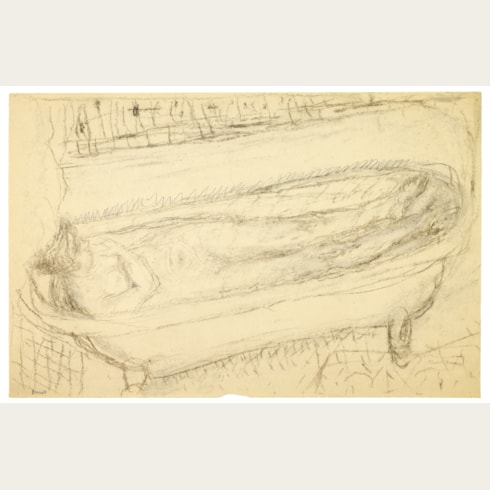Pierre BONNARD
(Fontenay-aux-Roses 1867 - Le Cannet 1947)
View of the Town and Bay of Saint-Tropez
Pencil, on a page from a small sketchbook.
Inscribed 2 chemises de couleur / 2 pairs chausettes fil / 5 mouchoirs on the verso.
Stamped with the Bonnard studio stamp (Lugt 3887) and the Antoine Terrasse vente stamp (not in Lugt) at the lower right.
105 x 157 mm. (4 1/8 x 6 1/8 in.)
Inscribed 2 chemises de couleur / 2 pairs chausettes fil / 5 mouchoirs on the verso.
Stamped with the Bonnard studio stamp (Lugt 3887) and the Antoine Terrasse vente stamp (not in Lugt) at the lower right.
105 x 157 mm. (4 1/8 x 6 1/8 in.)
In 1904 Pierre Bonnard made his first visit to the South of France. Together with Edouard Vuillard, he visited their fellow Nabis artist Ker-Xavier Roussel in Saint-Tropez, and also met Louis Valtat and Paul Signac. Captivated by the light and landscape of the Midi, which was different from anything he had painted before, Bonnard returned to Saint-Tropez for a longer stay in the summer of 1909 as the guest of Henri Manguin. From then on he was to spend a large part of his career in the South of France, painting yearly on the Côte d’Azur; in Saint-Tropez, Antibes, Grasse and at Le Cannet, in the hills above Cannes, where he purchased a villa in 1925.
In his drawings, Bonnard made use of whatever paper came to hand, sometimes lined or squared pages of cheap paper or small sketchbooks, generally of a small enough size to fit into his pocket, as well as yearly pocket diaries or agendas. As his great-nephew Antoine Terrasse has described them, Bonnard’s surviving sketchbooks or diaries, most dating from the 1920s, contain ‘innumerable quick sketches of figures, landscapes, nudes, or seascapes, all incredibly lively in spite of their small size.’ He tended to use a pencil for his sketches; as his friend George Besson recalled, ‘he had a predilection for an indescribably blunt pencil that was so short that a landscape or a nude seemed to spring from the ends of his three fingers around an invisible point.’
This drawing comes from a sketchbook used by Bonnard in 1921, which included other drawings of Saint-Tropez and the French coastline, as well as several views of Rome (some of which relate to a large painting of the Piazza del Popolo, Rome, painted in 1922 and today in a private collection). The artist spent the period between December 1920 and March 1921 staying with Manguin at Saint-Tropez, before spending a fortnight in Rome at the end of March. As Bonnard told a visitor to his studio in 1937, ‘I do these sketches outdoors as soon as I find a light effect, landscape, or atmosphere that moves me...It’s a matter of noting down whatever strikes you as quickly as possible. Then afterward you take a single color as a point of departure and compose an entire painting around it. Color has a logic as exact as that of form. One must not give up before capturing the first impression.’
In his drawings, Bonnard made use of whatever paper came to hand, sometimes lined or squared pages of cheap paper or small sketchbooks, generally of a small enough size to fit into his pocket, as well as yearly pocket diaries or agendas. As his great-nephew Antoine Terrasse has described them, Bonnard’s surviving sketchbooks or diaries, most dating from the 1920s, contain ‘innumerable quick sketches of figures, landscapes, nudes, or seascapes, all incredibly lively in spite of their small size.’ He tended to use a pencil for his sketches; as his friend George Besson recalled, ‘he had a predilection for an indescribably blunt pencil that was so short that a landscape or a nude seemed to spring from the ends of his three fingers around an invisible point.’
This drawing comes from a sketchbook used by Bonnard in 1921, which included other drawings of Saint-Tropez and the French coastline, as well as several views of Rome (some of which relate to a large painting of the Piazza del Popolo, Rome, painted in 1922 and today in a private collection). The artist spent the period between December 1920 and March 1921 staying with Manguin at Saint-Tropez, before spending a fortnight in Rome at the end of March. As Bonnard told a visitor to his studio in 1937, ‘I do these sketches outdoors as soon as I find a light effect, landscape, or atmosphere that moves me...It’s a matter of noting down whatever strikes you as quickly as possible. Then afterward you take a single color as a point of departure and compose an entire painting around it. Color has a logic as exact as that of form. One must not give up before capturing the first impression.’
A compulsive draughtsman, Pierre Bonnard relied on his studies and sketches extensively in the preparation of his pictures. Most of his drawings seem to have been made in the process of developing the composition of a painting, and indeed he seems to have preferred to work from drawings rather than relying on direct observation. He made use of whatever paper came to hand, sometimes lined or squared pages of cheap paper or small sketchbooks, and generally of a small enough size to fit into his pocket. He almost always used a hard or soft pencil and only very rarely applied colour to his drawings, relying on the strength and shading of the pencil strokes to suggest tone and colour. In conversation with his nephew Charles Terrasse, Bonnard noted that ‘I am drawing incessantly - after drawing comes the composition which must have a perfect equilibrium, a well constructed picture is the battle half won, the art of composition is so powerful that with only black and white - a pencil, a pen or a lithographic pencil, one arrives at results as complete and of a quality nearly as beautiful as with a whole arsenal of colours.’
Bonnard rarely parted with his drawings, which were never intended to be exhibited or, indeed, regarded as independent works of art. Nevertheless, the artist’s work as a draughtsman is crucial to an understanding of his approach to painting. As Jack Flam has written, ‘Bonnard’s drawings are often very small, and as a result they are frequently overlooked in discussions of modern drawing. But their formal variety and sensitivity of touch are remarkable, as is the often fluctuant nature of their imagery. Although many of Bonnard’s drawings seem like shorthand notations of visual information recorded for later use in paintings, they are nonetheless effective as independent entities precisely because of the intensity of perception they incorporate. They also demonstrate an extraordinary sensitivity to the nature of the medium itself, unadorned by elaborate technical procedures.’
Provenance
By descent from the artist to his nephew, Charles Terrasse, Paris
Thence by descent to his son, Antoine Terrasse, Fontainebleau
Thence by descent until 2015.
Thence by descent to his son, Antoine Terrasse, Fontainebleau
Thence by descent until 2015.

